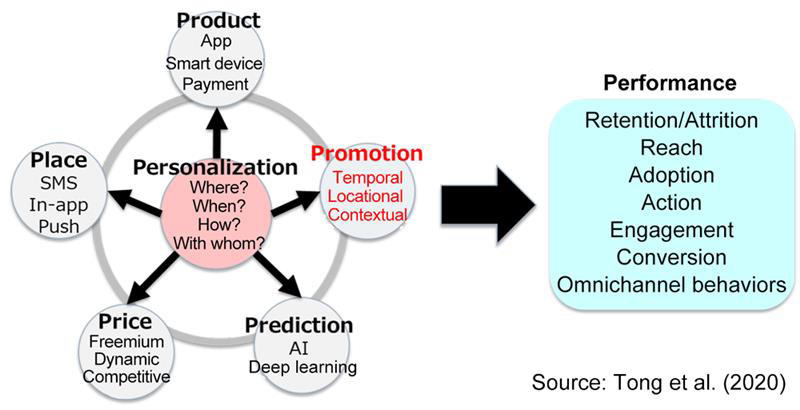Mobile Marketing Where Timing Is Important
Takashi Teramoto/Professor, Faculty of Commerce, Chuo University
Areas of Specialization: Marketing Theory and Consumer Behavior Theory
Excessive mobile marketing and consumer fatigue
Within mobile marketing, there is particular expansion in the market for O2O (Online to Offline) marketing, which approaches consumers through online advertising and encourages them to make purchases at stores. In fact, according to estimates by CyberAgent, which is the largest internet advertising agency, the market size will expand approximately 12 times by 2024, from about 20 billion yen in 2018.[1]
Mobile marketing has many possibilities in terms of contact points with consumers. For example, in the case of coupons that are issued at a retail store, the point of contact with customers is limited to the point of issuance; in other words, at stores. On the other hand, mobile coupons make it possible to connect with customers in a variety of situations, not just at stores.
However, there are concerns from the perspective of consumers who are the recipients of mobile marketing. In a questionnaire survey conducted by Nomura Research Institute on consumer attitudes toward digital advertising, the majority of respondents replied that "I'm bothered by the excessive amount of product information in digital advertising" and "I don't want to register my personal information, even if it creates the benefit of increased convenience."[2] These results seem to suggest that in the Japanese market, consumers feel information fatigue and overwhelmed toward mobile marketing, and are wary of abuse of their personal information.
In this case, instead of blindly approaching consumers, it seems important to create a mechanism that will be easily accepted by consumers; that is, the appropriate approach at the appropriate timing.
Example of mobile marketing that emphasizes appropriate timing
So, how should we grasp the timing when mobile marketing will resonate? Here, I would like to introduce the framework proposed by Tong et al.[3] Tong and his co-authors proposed the Six Ps (6Ps) as the personalized mobile marketing mix. By fully utilizing the 6Ps mix, Tong et al. suggest the need to obtain the results of consumer reactions such as customer retention/attrition and customer engagement. (Figure).
Figure: Framework of personalized mobile marketing mix

In particular, promotion should be focused on here. Promotion refers to the design and implementation of promotional campaigns that incorporate temporal, locational, and contextual information unique to mobile technology. In other words, it shows that the elements of appeal based on timing, which is a major feature unique to mobile, can be organized into the three elements of temporal, locational, and contextual. It is desirable to consider promotions from the perspective of how the three timing elements of temporal, locational, and contextual fit the target consumers.
A large amount of research on mobile marketing that utilizes the three timing elements of temporal, locational, and contextual is being conducted overseas.[4] For example, in terms of temporal element, there are cases where it is better to promote high-involvement products that require information searches in the morning, and low-involvement products that do not require information searches in the evening. In terms of locational element, it is more effective to offer coupons to mobile users who are near the target store. When it comes to contextual element, it is effective to direct marketing at users when they are immersed in their mobile devices on the train or when with their friends. Furthermore, there are cases where free Wi-Fi access logs are used to conduct promotions based on the behavior history of mobile users inside shopping malls. These research cases of mobile marketing overseas are very helpful when considering the timing of marketing approaches.
At what timing are consumers likely to accept marketing?
However, when these overseas cases are compared to the Japanese market environment, there is a sense that they are a bit excessive when considering how consumers are aware of privacy. As mentioned earlier, an approach which depends heavily on information collected through mobile devices may create a sense of distrust in consumers. Instead, it's important to find a simple and incisive timing when consumers are likely to accept marketing, and then to conduct marketing aimed at that timing.
In the Japanese market, consumers are fatigued and overwhelmed with information. They are also wary of abuse of their information. In such a market, what is the time when consumers are most likely to accept marketing? The best timing is when a consumer is considering a purchase; that is, when the consumer is in shopping mode. There are two situations in which this shopping mode can be visualized. Obviously, one situation is when a consumer is actually shopping at a retail store. The other situation is when a consumer is making a shopping list. This is a situation in which the consumer is making a list of things which they want to purchase; in other words, visualizing their shopping plan.
If a consumer writes their shopping list on paper, it is difficult to capture the timing of creating the memo as data. However, if a consumer is inputting their list into a mobile device, capture as data is possible. Therefore, it would be a good timing to conduct marketing to consumers when they are inputting their shopping list into a mobile device.
[1] CyberAgent (2019), Survey of Size of Domestic O2O Advertising Market, CyberAgent, Inc. Press Release, June 3, 2019. https://www.cyberagent.co.jp/news/detail/id=23249 (Access date: September 12, 2023)
[2] Nomura Research Institute (2018), Changes in Japanese Values and Consumption Behavior as Seen in the Eighth Questionnaire Survey of 10,000 Consumers: Trend Towards Individual Activity Using Information Terminals Continues, Taking Away "Family Time;" Knowledge Insight Report, November 6, 2018. https://www.nri.com/jp/knowledge/report/lst/2018/cc/mediaforum/forum272 (Access date: September 12, 2023)
[3] Tong, S., Luo, X. & Xu, B. (2020), "Personalized Mobile Marketing Strategies," Journal of the Academy of Marketing Science, 48, pp. 64-78.
[4] Please refer to the following paper for details on this case: Takashi Teramoto (2021), Examples of Measuring the Effectiveness of Mobile Marketing Overseas and Approaches Unique to Japan, the Journal of Marketing and Distribution, 552, pp. 4-10.
Takashi Teramoto/Professor, Faculty of Commerce, Chuo University
Areas of Specialization: Marketing Theory and Consumer Behavior TheoryTakashi Teramoto was born in Yokohama City. He graduated from the Faculty of Business and Commerce, Keio University in 1998 and completed his studies in the Graduate School of Business Sciences, the University of Tsukuba in 2011. He holds a PhD in business administration. He served as Senior Researcher in the Distribution Economics Institute of Japan, Associate Professor at Meisei University, and Associate Professor and then Professor at Yokohama National University before assuming his current position in 2022.
His areas of expertise are marketing theory and consumer behavior theory. In particular, his research focuses on quantitative analysis of consumer purchasing behavior and retail strategy.
His main written works include Brand Communication from a Retail Perspective (sole author, Chikura Publishing Company, 2012; awarded the Encouragement Award from the Japan Society of Marketing & Distribution) and Branding for Grocers (sole author, Chikura Publishing Company, 2019).









